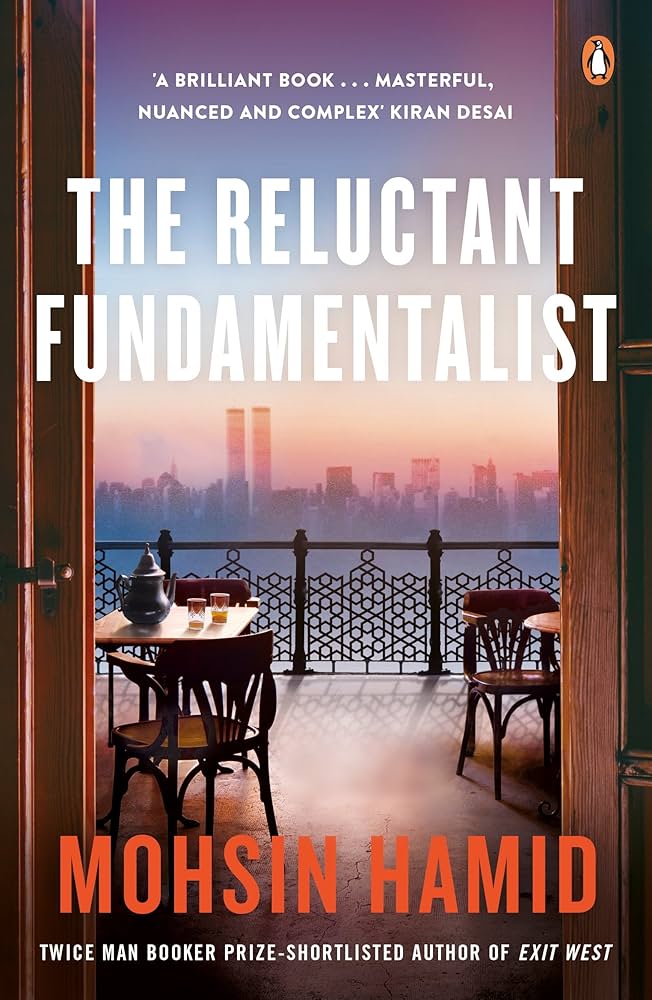In a world increasingly defined by shifting allegiances and complex cultural landscapes, Mohsin Hamid’s The Reluctant Fundamentalist emerges as a compelling exploration of identity and conflict. This novel deftly navigates the turbulent waters of self-perception and external expectation, inviting readers to question how personal and political narratives intertwine. As we delve into Hamid’s nuanced storytelling, this review seeks to unravel the intricate threads that bind the protagonist’s internal struggles to broader themes of belonging, suspicion, and change.
Unpacking the Complex Themes of Identity and Belonging in The Reluctant fundamentalist
Mohsin Hamid masterfully weaves a narrative that navigates the fragile intersections of identity and belonging within a post-9/11 world. The protagonist’s journey is not merely about reconciling cultural dichotomies but also about confronting the external gaze that polices one’s sense of self. Through a nuanced portrayal, the novel explores how perceptions of loyalty, patriotism, and otherness shape and often fracture personal identity. The tension is palpable – caught between the allure of Western prospect and the pull of ancestral roots, the narrative probes questions such as:
- What does it mean to truly belong in a globalized yet divided society?
- How does external suspicion alter internal self-conception?
- Can identity remain fluid when bound by geopolitical conflict?
These questions bloom into a larger commentary on the immigrant experience, where identity becomes a battleground for recognition and acceptance. The novel’s subtle use of unreliable narration and shifting perspectives highlights how belonging is not a fixed state but a continuous negotiation. The following table encapsulates some of the core conflicts faced by the protagonist:
| Conflict | Internal Struggle | External Pressure |
|---|---|---|
| Cultural Identity | Balancing heritage and modernity | Stereotyping and alienation |
| Belonging | Yearning for acceptance | Prejudice after 9/11 |
| Loyalty | Conflicted patriotism | National suspicion |
Exploring the Narrative Structure and Its Impact on Reader Perception in Hamid’s Novel

The novel’s impact is further amplified through its deliberate pacing and controlled revelation of data. Key narrative techniques that shape the reader’s perception include:
- Second-person address that creates discomfort and immediacy
- Omission and silence which add layers of suspense and mistrust
- Nonlinear flashbacks that reveal backstory in fragments, emphasizing uncertainty
- Ambiguous ending which invites interpretation rather then resolution
Together, these narrative elements orchestrate a powerful exploration of identity, prejudice, and alienation-compelling readers to confront their own biases and the complexities of cultural conflict.
| Narrative Technique | Effect on Reader |
|---|---|
| Unreliable Narrator | Provokes doubt and critical engagement |
| Second-person POV | Heightens intimacy and tension |
| Nonlinear Flashbacks | builds mystery and emotional depth |
| closed yet Open-Ended Plot | Leaves lasting ambiguity and reflection |
The role of Cultural Conflict in Shaping the Protagonist’s Journey and Internal Struggle

At the heart of the narrative lies the protagonist’s navigation through a labyrinth of cultural expectations and prejudices. His experience is not merely external but deeply internal, where each encounter with conflicting values carves new fissures in his sense of self. This tension between East and West operates both as a catalyst for change and a source of profound alienation, forcing him to continuously reassess where he belongs. the cultural conflict amplifies his internal struggle, making identity a contested battlefield where allegiance and doubt coalesce.
Key elements shaping this journey include:
- Confrontation with stereotypes and societal mistrust in a post-9/11 context
- The pull between personal ambition and collective cultural heritage
- The evolving perception of homeland versus adopted country
| Cultural Dimension | Impact on the Protagonist | Symbolism |
|---|---|---|
| East (Pakistan) | source of identity and familial ties | Rootedness and tradition |
| West (USA) | Opportunity and alienation | Freedom and suspicion |
This layered conflict propels the narrative forward,turning the protagonist’s external experiences into a mirror reflecting his evolving psyche. The oscillation between belonging and estrangement mirrors a global quest for identity in an increasingly polarized world, underscoring how personal journeys are inextricably tied to broader cultural tensions.
how Post-9/11 Global Politics Influence Character Development and Storytelling Dynamics

Mohsin Hamid’s narrative masterfully encapsulates the seismic shifts in global politics that followed 9/11, embedding these transformations deeply within his protagonist’s psyche. The character’s journey reflects a turbulent collision between personal identity and external perception,shaped by a world suddenly wary and divided.This dynamic tension propels the story beyond mere geopolitical commentary-it unpacks the intricate realities faced by individuals caught in the crossfire of suspicion and belonging.Here, the global political landscape functions less as background and more as an active catalyst, molding character motivations and challenging traditional binaries of loyalty and alienation.
Storytelling in this context is notably fragmented and charged with ambiguity, mirroring the fractured international order. Hamid employs a narrative style that eschews straightforward allegiances, instead favoring a nuanced exploration of conflict through:
- Unreliable narration that blurs truth and perspective
- Cultural hybridity that defies simplistic categorization
- Ambivalent emotional landscapes, reflecting the uncertainty pervasive in post-9/11 global relations
Consequently, the story becomes a site where identity is perpetually negotiated, not only between East and West but within the fractured self-a mirror to the global complexity of the era.
| Political Reality | Impact on Storytelling |
|---|---|
| Heightened Surveillance Culture | Creates atmosphere of paranoia, influencing character mistrust |
| East-West Polarization | Drives thematic exploration of dual identity and ambiguity |
| Globalized Economic Uncertainty | Shapes character aspirations and existential dilemmas |
Analyzing the Use of Ambiguity and unreliable Narration to Challenge Assumptions About Truth
in The Reluctant Fundamentalist, Mohsin hamid masterfully employs ambiguity and unreliable narration as tools to unsettle readers’ perceptions of truth. The protagonist’s monologue is laced with subtle contradictions and unexplained silences, compelling readers to question not just what is being said, but also what remains unsaid.This narrative strategy mirrors the fractured identities and contested loyalties central to the novel, creating a tension that challenges assumptions about cultural and political certainties. Rather than presenting a linear account, Hamid invites us into a labyrinth of doubt where single, objective truths dissolve into multiple, competing versions of reality.
Key narrative elements include:
- Subjectivity of Perspective: The story is delivered solely through Changez’s viewpoint, whose reliability is compromised by his emotional investment and possible biases.
- Strategic ambiguity: Key events and motivations are left open to interpretation,prompting readers to actively piece together fragments of meaning.
- Symbolic Silence: Moments where Changez’s withholding of information become as notable as his declarations, highlighting the elusive nature of truth.
| Technique | Effect on Reader | Example in Novel |
|---|---|---|
| Unreliable Narrator | Creates skepticism and multiple interpretations | Changez’s ambiguous recounting of encounters |
| Ambiguous dialog | Blurs clear moral boundaries | Open-ended conversations with the American listener |
| Intentional Gaps | Invites active reader engagement | Unexplained absences in Changez’s backstory |
The Intersection of Personal and political Identity Within the Context of East-West Relations
Mohsin Hamid’s narrative deftly navigates the complex terrain where personal identity clashes and converges with political ideologies. The protagonist’s journey is not merely a tale of self-discovery but a vivid illustration of how individual identity becomes inextricably linked to global perceptions and biases. Through the lens of East-West dynamics, the story unfolds a multilayered conflict:
- Personal loyalty versus national allegiance
- Cultural heritage meeting globalized modernity
- Self-perception challenged by external political narratives
These tensions sharply highlight how identity is never static but constantly reshaped by socio-political forces. Hamid’s work invites readers to examine the fluid boundaries of belonging and the impact of geopolitical suspicion on intimate human connections.In this way, the protagonist’s internal struggle becomes emblematic of a broader social commentary on how identities are both politicized and personalized.
| Aspect | Personal Identity | political Identity |
|---|---|---|
| Driver | Family,culture,language | Nationalism,global politics |
| Effect | Sense of belonging,self-expression | Alienation,surveillance,suspicion |
| Response | Adaptation,introspection | resistance,conformity |
Symbolism and Metaphor as tools to Illustrate Tensions Between Modernity and Tradition
Mohsin Hamid expertly employs symbolism and metaphor to navigate the fraught space between modernity and tradition,crafting a narrative that pulses with cultural tension and personal conflict. The titular character’s journey is rife with symbolic gestures-from the tea-drinking rituals symbolizing rooted tradition to the urban landscapes representing the ever-encroaching forces of globalization. These symbols act as silent dialogues, revealing the internal and external struggles that define the protagonist’s existence. As a notable example, Hamid’s recurrent use of the American cityscape functions not just as a setting but as a metaphorical crossroads where Eastern identity clashes and sometimes converges with Western modernity, underscoring the precarious balance between assimilation and resistance.
Furthermore, metaphorical devices breathe life into the novel’s exploration of identity as a fluid, contested construct. The tension between old world values and contemporary ideologies is vividly illustrated through the metaphor of the “reluctant fundamentalist” himself-someone caught at the intersection of faith, loyalty, and modern skepticism. The novel’s atmosphere, thick with suspicion and uncertainty post-9/11, is reflected in metaphors of shadows and mirrors, amplifying themes of alienation and self-scrutiny. below is a simple breakdown of key symbols and metaphors central to the narrative:
| symbol/Metaphor | Meaning | Relation to Theme |
|---|---|---|
| Tea rituals | Hospitality, tradition | Anchors identity in cultural heritage |
| American cityscape | Modernity, opportunity, alienation | Represents conflicting cultural forces |
| Shadows and mirrors | Self-examination, hidden truths | Symbolizes internal conflict and societal scrutiny |
| Reluctance | Resistance, hesitation | Embodies the tension between assimilation and fidelity |
Stylistic Choices and Language That Enhance the Emotional Resonance of the Narrative
Mohsin Hamid’s narrative style in The Reluctant Fundamentalist masterfully employs a conversational tone that draws the reader into an intimate dialogue with the protagonist, Changez. The use of a second-person perspective not only blurs the lines between narrator and audience but also creates a palpable tension and immediacy. This technique fosters a subjective experience, making the emotional turmoil and identity conflicts more visceral. Moreover, Hamid’s strategic use of pauses and ellipses mimics natural speech patterns, enhancing the authenticity of Changez’s reflections and the lingering uncertainties that permeate his journey.
Language in the novel is carefully crafted to reflect the clash of cultures and internal contradictions faced by Changez. Hamid’s choice of simple yet evocative diction allows for complex emotional states to be conveyed with subtlety and restraint. Repetition of key words and phrases throughout the narrative serves as a rhythmic reminder of Changez’s evolving mindset and the persistent pull of his past. Below is a brief overview of stylistic devices and their emotional impact:
| Stylistic Device | Emotional Effect |
|---|---|
| Second-Person Narrative | Creates intimacy and tension between reader and protagonist |
| Ellipses and Pauses | Conveys hesitation, uncertainty, and introspection |
| Repetition | emphasizes internal conflict and cyclical thoughts |
| Simple Diction | Enhances clarity, emotional accessibility, and universality |
Why The Reluctant Fundamentalist Remains relevant for Contemporary Discussions on Identity
The Reluctant Fundamentalist captures the multifaceted nature of identity in an increasingly globalized yet fragmented world. The novel’s exploration transcends cultural and geopolitical borders, delving into how external perceptions and internal conflicts shape self-understanding. In an era marked by widening divides-be it ethnic, religious, or ideological-Mohsin Hamid’s narrative challenges readers to consider the precarious balance between belonging and alienation. It is not merely a story about post-9/11 tensions, but rather a nuanced probe into the ongoing negotiation between personal identity and imposed stereotypes, making it continually pertinent for contemporary discourse.
Several themes from the novel resonate deeply with current societal dialogues:
- ambiguity of Loyalty: The protagonist’s shifting allegiances highlight the complex reality of diasporic identities.
- Perception vs.Reality: The contrast between how individuals view themselves and how they are viewed by society exposes ingrained biases.
- Economic and cultural Globalization: The novel underscores the tensions between opportunity and exploitation in a global context.
This interplay invites readers to rethink fixed notions of identity amid conflict and cultural exchange, proving the novel’s enduring relevance.
| Theme | Contemporary Relevance |
|---|---|
| Identity Fluidity | Challenges rigid classifications in multicultural societies |
| Conflict & Misunderstanding | Reflects modern struggles surrounding nationalism and globalism |
| power Dynamics | explores inequalities embedded in postcolonial and economic contexts |
Recommendations for Readers Seeking Insightful Perspectives on Conflict and Self-Discovery
For readers eager to delve deeper into the intricate dance between identity and personal conflict, a thoughtful exploration of narratives that challenge and expand perception is essential. Engaging with works that illuminate the tensions between cultural belonging and self-discovery helps frame a broader understanding of the delicate balance each individual navigates. Consider exploring:
- “The Namesake” by Jhumpa Lahiri – Explores immigrant identity through the lens of family heritage and personal transformation.
- “Americanah” by Chimamanda Ngozi Adichie – Offers a powerful narrative on race, displacement, and self-reinvention in modern society.
- “Exit West” by Mohsin Hamid – Another masterpiece from Hamid, blending magical realism with the realities of migration and change.
| Book | Theme | insight Offered |
|---|---|---|
| Persepolis | Revolution & Identity | Childhood displacement and self-realization amid conflict |
| The Kite Runner | Guilt & Redemption | Explores personal conflicts shaped by political upheaval |
| Home fire | Family & Loyalty | Complex identity struggles shaped by contemporary geopolitics |
These selections serve as companions for readers wishing to engage critically with the psychological and societal fissures portrayed in The Reluctant Fundamentalist. They each unfold unique layers of self-exploration through the prism of external turmoil, inviting reflection on how conflict and personal evolution are invariably intertwined. By immersing in these diverse stories, one can better appreciate the nuanced portrait of identity Mohsin Hamid presents and extend those insights into broader discussions on cultural and personal transformation.
Comparing Hamid’s Approach to Identity With Other Contemporary South Asian Authors
Mohsin Hamid’s narrative in The Reluctant Fundamentalist approaches identity as a fluid and multifaceted construct, shaped significantly by external political climates and internal cultural conflicts. Unlike many contemporary South Asian authors who frequently enough anchor identity firmly within historical or communal contexts, Hamid embraces ambiguity and tension as essential to the self’s evolution. His protagonist’s journey reflects a push-and-pull between Western assimilation and Eastern heritage, illuminating how globalization complicates traditional identity markers.This nuanced portrayal contrasts with writers like Arundhati Roy or Jhumpa Lahiri, who may emphasize nostalgia and memory but less frequently explore identity as a battleground of conflicting loyalties amplified by geopolitical forces.
To better understand these distinctions, consider the following key thematic contrasts:
- Hamid: Identity as an ongoing negotiation within conflict and power dynamics.
- Roy: Identity intertwined with colonial history and socio-political activism.
- Lahiri: Emphasis on personal and familial identity through immigrant experiences.
| Author | Focus on Identity | Approach to Conflict |
|---|---|---|
| Mohsin Hamid | Dynamic and politically charged | Internal & external tension, ambiguity |
| Arundhati Roy | History and resistance | Socio-political, rooted in activism |
| Jhumpa Lahiri | Family and diaspora | Emotional, cultural dislocation |
The Lasting Impact of The Reluctant Fundamentalist in Literary and Sociopolitical Conversations
The work’s influence extends beyond literary circles, sparking debates about representation and identity politics across multiple platforms. its impact is frequently enough highlighted in forums addressing:
- Cross-cultural misunderstandings rooted in fear and stereotyping
- The paradox of assimilation versus authenticity
- Challenges of diaspora and belonging
- The role of storytelling in mediating historical and political narratives
| Aspect | Literary Impact | Sociopolitical Impact |
|---|---|---|
| Narrative Style | Unreliable narrator inviting multiple interpretations | Encourages skepticism of media-driven stereotypes |
| Themes | identity, alienation, and transformation | Debates on immigration and cultural integration |
| Characterization | Complex, multifaceted protagonist | Humanizes marginalized perspectives |
An Insightful Look Into Mohsin Hamid’s Life, Inspirations, and Literary Contributions
Beyond his captivating narratives, Hamid’s literary contributions extend to his innovative use of structure and voice. Employing a dramatic monologue and an unreliable narrator, he challenges readers to question the nature of truth and bias in post-9/11 geopolitics.The themes he tackles resonate widely, offering insight into the experiences of those living in diasporic limbo. His work also serves as a mirror reflecting societal tensions, urging empathy and understanding across cultural divides.
- Identity and Displacement: Central themes across Hamid’s oeuvre
- Innovative Narrative Styles: Use of first-person, dramatic monologues
- Political and Social commentary: Reflections on post-9/11 world
| Aspect | Reflection in The Reluctant Fundamentalist |
|---|---|
| Cultural Identity | A protagonist torn between Eastern roots and Western experiences |
| Conflict | Internal struggle amidst external political tensions |
| Perspective | Unreliable narrator challenges reader’s assumptions |
In unraveling the intricate layers of Mohsin Hamid’s The Reluctant Fundamentalist, we find a narrative that refuses easy answers, compelling readers to navigate the murky intersections of identity, belonging, and prejudice. The novel’s deliberate ambiguity mirrors the complexities of a world where lines between self and other blur, challenging us to confront uncomfortable truths about perception and conflict. As the final pages linger, Hamid leaves us not with resolution, but with resonance-an invitation to continue questioning the stories we tell ourselves about identity in a fractured global landscape.












